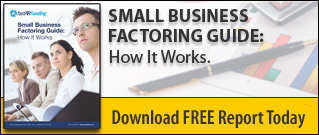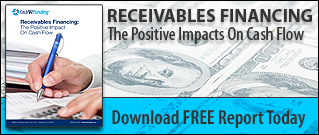 Okay, let’s say you’re a small business owner. Regardless of the nature of your business (i.e. manufacturing, distribution, etc.), there is one important thing that’s required to effectively run your business. Can you guess what that one thing is? If you guessed cash, then you’re right!
Okay, let’s say you’re a small business owner. Regardless of the nature of your business (i.e. manufacturing, distribution, etc.), there is one important thing that’s required to effectively run your business. Can you guess what that one thing is? If you guessed cash, then you’re right!
If you find that your business struggles with cash flow at times, then there are a number of ways to raise capital and help improve cash flow.
-
The first would be to find an investor that’s willing to take a chance on your business. This may result in you losing some control in the way your business is run.
-
The second way is to efficiently convert your accounts receivables into cash. You and I both know this is easier said than done. Depending on your operating cycle (or cycles in some cases) this is difficult. Cash flow is tight based on the speed of your receivables turning. This results in you struggling to make that all-important Friday payroll and keep your vendors happy.
-
The third way to help cash flow, and ultimately the topic of my discussion, is receivables financing or factoring.
What is Factoring?
To start, factoring is a relatively easy way for a business to generate cash by selling their accounts receivables to a third party, known as a factor. The ability for you as a business owner to factor receivables is primarily dependent on the strength of your customers. The stronger the credit worthiness of a particular customer, the more you will be able to factor.
Factoring finance allows businesses to obtain much-needed cash faster than what it takes to collect receivables. This allows you to make your Friday payroll and pay your vendors.
Factoring Finance Strategies
Now that we’ve established what factoring finance is, let’s discuss some simple and cost-effective strategies for factoring receivables.
-
The first strategy, and the most simplistic, is to factor all of your receivables. Yes, fees are owed, but it’s a small price to pay to have the cash on hand necessary to conduct your day-to-day operations (make payroll, pay vendors, etc.).
-
Second, are you a business owner that offers quick-pay discounts? If the answer is yes, then you may want to either stop offering quick-pay discounts or minimize them. If you’re factoring your receivables, then you’ve got the cash you need. I make this recommendation simply because I have seen clients honor the discount even if their customers are not paying in the required time frame.
-
Third, you may find there are just certain times that you need a little help with your cash flow. You may only want to factor some of your receivables. Look at factoring your more creditworthy customers only. There’s a chance the more creditworthy customer pays faster. This way you are minimizing your factoring charges while meeting your cash needs.
Conclusion
Factoring finance is an efficient way to help maintain the cash flow necessary to run your business. I’ve been in commercial finance for over six years in various capacities, and I can’t tell you how many businesses I’ve seen grow and develop through the use of factoring. The strategies I’ve discussed above have all worked for many different kinds of clients. If you own a small business that struggles with cash flow at times, it may be an option for you. Best of luck!
Learn more about factoring and Fast A/R Funding’s services by downloading our informative “Factoring 101” guide, or call 888.833.2286 to speak with one of our small business finance consultants.










